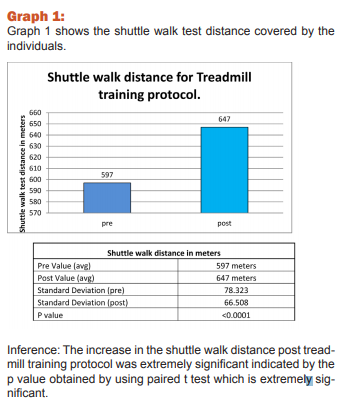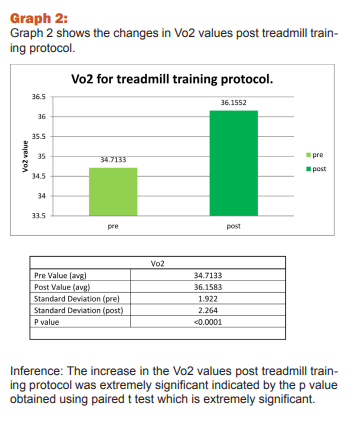IJCRR - 6(20), October, 2014
Pages: 61-65
Date of Publication: 20-Oct-2014
Print Article
Download XML Download PDF
COMPARISON OF TREADMILL VERSUS CYCLE ERGOMETER TRAINING ON FUNCTIONAL EXERCISE CAPACITY IN NORMAL INDIVIDUALS
Author: Zahara K. Polen, Snehal Joshi
Category: Healthcare
Abstract:Background : There is an increasing awareness among the people about fitness and health. The bicycle ergometer and treadmill are the commonest forms of indoor aerobic exercises. Motor driven treadmill exercise is similar to walking or jogging or running depending upon the speed of the treadmill. In case of bicycle ergometer the amount of exercise can be controlled voluntarily by pedaling the cycle with predefined resistance. Aim of Study: The study was aimed at finding out the effects of these commonly used machines in gyms and in cardiovascular rehabilitation and comparing these effects. Methodology: type of study \? experimental type. • Subjects were randomly allotted into two groups of 10 each. One group underwent treadmill training and the second group underwent cycle ergometer training for 30min, 3days per week for four weeks. The intensity of training was within 60% to 70% of age matched target heart rate(5) which was monitored using pulse oximeter.(12) • Shuttle walk test was admistered pre and post training and the results were recorded. • Vo2 was calculated using the formula (0.0289 *distance)+17.46.(6) • Results were analysed using paired t test for intra group analysis and unpaired t test for inter group analysis. Results: According to the study conducted the increase in shuttle walk distance and Vo2 values post treadmill training and cycle ergometer training were found to be extremely significant. No significant difference was seen between the improvements in two groups.Conclusion: Our study concludes that, treadmill and bicycle ergometer are equally effective in improving functional exercise capacity.
Keywords: Fitness, Aerobic exercises, Shuttle walk test, Vo2 values, Heart rate, Treadmill, Cycle ergometer
Full Text:
INTRODUCTION
Physical fitness is a state of well-being with low risk of premature health problems and energy to participate in a variety of physical activities. Physical fitness is classified into health related and skill related categories. Health related fitness is the ability to perform activities of daily living without undue fatigue. Its components are cardiorespiratory endurance, muscular strength and endurance, flexibility and body composition. (1) Physical fitness is generally achieved through correct nutrition, exercise, hygiene and rest. To stay healthy, it is important to engage in physical activity. The primary recommendations from the ACSM and AHA regarding guidelines for physical activity suggest that all healthy adults aged 18 to 65 need moderate-intensity aerobic physical activity for a minimum of 30 minutes five days per week, or vigorous activity for a minimum of 20 minutes three days per week.(2) Aerobic exercise is associated with low-intensity, repetitive exercise of large muscle groups performed over an extended period of time. Aerobic exercise depends primarily on the aerobic energy-generating process. Aerobic refers to the use of oxygen to adequately meet energy demands during exercise via aerobic metabolism. This mode of exercise primarily increases muscular and cardiopulmonary endurance. Aerobic exercises include walking, cycling, jogging, running, swimming, skating, and skiing. Indoor aerobic exercises include treadmill, stationary bicycle, elliptical trainer, stair climbing, etc. (3) The bicycle ergo meter and treadmill exercises are the commonest to perform as indoor aerobic exercises. The motor driven treadmill exercise can be similar to walking or jogging or running if the speed of the treadmill motor is changed accordingly .Bicycle ergometer is exercise is similar to cycling. The intensity of exercise can be changed by varying the amount of resistance. There is an increasing awareness among the people about fitness and health. Healthy adults are being encouraged to exercise regularly to fight the effects of aging and avoid health problems. There has been a significant increase in the number of people joining health clubs, gyms and other fitness centers. A study was conducted which found that Values of HRmax were significantly higher on treadmill than cycle ergometer for each testing session. The subjects had significantly higher relative VO2max on treadmill than cycle ergometer for each testing session. (9) In a study conducted, it was found that ground walk training increased endurance walking capacity more than cycle training and was similar to cycle training in improving peak walking capacity, peak and endurance cycle capacity and quality of life. (10) This study was attempted to see whether treadmill training and cycle ergometer training improves functional exercise capacity and which of the two machines has a better effect, since both these equipments have their own advantages and disadvantages. The change in functional exercise capacity was indicated by shuttle walk distance and Vo2 consumed pre and post training.
MATERIALS AND METHODOLOGY
The project was sent to Ethical committee for approval and clearance was obtained. Healthy subjects between 18 to 24 years of age were selected. PAR-Q was administered to the subjects. The subjects were informed about the project and written consent was obtained. Study Type: Experimental Type. Inclusion Criteria: Healthy individuals of age group 18 to 24 years. Exclusion Criteria: Person with 1. Normal individual training in a gym or exercising regularly 2. A known Cardiac and Respiratory disorder 3. Any systemic Illness at the time of training and 4. Lower limb orthopaedic problems Materials used: Treadmill, bicycle ergometer, pulse oximeters to monitor heart rate during exercise, 10m track for shuttle walk test, shuttle walk test, audio CD, CD player, calculator, book and a pen.
METHODOLOGY
• Shuttle walk test was administered to each healthy subject and results were recorded.
• Subjects were randomly allotted into two groups. One group underwent treadmill training and the second group underwent cycle ergometer training for 30min, 3days per week for four weeks. The intensity of training was within 60% to 70% of age matched target heart rate(5) which was monitored using pulse oximeter.(12)
• At the end of four weeks, subjects were reassessed using shuttle walk test and the results were recorded.
• Vo2 was calculated using the formula (0.0289 *distance)+17.46.(6)
• The Shuttle Walk Test (SWT) is a submaximal, standardized, incremental walking test that measures functional capacity by exercising an individual to a symptom limited maximal performance.
This incremental exercise test requires patients to walk at increasing speeds back and forth a 10-m course. (6)
STATISTICAL TESTS
Results were analysed using paired t test for intra group analysis (i.e for pre and post effect of each) and unpaired t test for inter group analysis (i.e for pre and post effect of each).
RESULTS
On observational analysis it was seen that there was a significant increase in exercise capacity brought about by treadmill training protocol and cycle ergometer training indicated by the increase in shuttle walk test distance and Vo2 values post training protocol. There was no significant difference between the improvements in exercise capacity in treadmill as compared to bicycle ergometer.
DISCUSSION
The increase in shuttle walk distance and Vo2 values post training protocol on treadmill as well as cycle ergometer is due to the adaptations in skeletal muscle and bone, metabolic changes and cardiovascular adaptations that take place in the body following aerobic exercise and training. (7) Skeletal muscle adapts to endurance training chiefly through a small increase in the cross-sectional area of slow-twitch fibers, because aerobic activity primarily recruits these fibers. Endurance training also increases number of capillaries in skeletal muscle, thereby allowing a greater capacity of blood flow in the exercised muscle. (7) Significant metabolic adaptations occur in skeletal muscle in response to endurance training. Both the size and number of mitochondria increase substantially as does the activity of oxidative enzymes. Myoglobin content in the muscle is also augmented. Such adaptations combined with increase in capillary and muscle blood flow in the trained muscle, greatly enhance the oxidative capacity of endurance trained muscle. (7) After training, stroke volume is increased at rest, during submaximal exercise, and during maximal exercise; conversely, post training heart rate is decreased at rest and during submaximal exercise and is usually unchanged at maximal rates of work. The increase in stroke volume appears to be the dominant change and explains most of the changes observed in cardiac output. Arterial blood pressure at rest, blood pressure during submaximal exercise, and peak blood pressure all show a slight decline as a result of endurance training. (7) Body response to exercise depends on the type of exercise. Cardiovascular changes again depend on the type of exercise and severity of exercises. Cardiovascular responses differ in bicycle ergometer exercise and treadmill exercise as the method of exercise differs. Studies have shown that increase in heart rate was more in treadmill exercise compared to bicycle ergometer exercise. Systolic blood pressure increases more in treadmill exercise compared to bicycle ergometer exercise due to more sympathetic activation. (8) The study conducted also shows no significant difference between improvements in between the two groups that is treadmill and bicycle trained individuals. This is due to the fact that both types of exercises primarily focus on large muscles of the lower limb. Responses in the exercised muscle produce an effect on central circulation and leg blood flow. In both cases similar muscular and cardiovascular adaptations are produced responsible for the increase in shuttle walk distance and increased V02 value in both groups. Hence treadmill and bicycle ergometer can be interchangeably used for training.
CONCLUSION
The study shows that there is an extremely significant increase in exercise capacity brought about by treadmill training protocol indicated by the increase in shuttle walk test distance and Vo2 values post training protocol. The increase in exercise capacity post cycle ergometer training protocol was very significant as indicated by the increase in shuttle walk distance and Vo2 values. There was no significant difference between the improvements in exercise capacity in treadmill as compared to bicycle ergometer. Thus, it is concluded that, treadmill and bicycle ergometer are equally effective in improving functional exercise capacity.
CLINICAL IMPLICATION:
Since both treadmill and cycle ergometer are equally effective in improving functional exercise capacity, they can be used interchangeably or as per convenience. Treadmill can be used by younger individuals as it brings about higher energy expenditure as compared to bicycle. (11) Also walking is a familiar movement pattern as opposed to cycling. Since treadmill walking or running is in the weight bearing position it puts more stress on the joints especially the knees and may not be suitable in individuals with arthritis or injuries. Also it involves exercising on an unstable surface and can be hazardous for individuals with poor balance. Bicycle ergometer is a non weight bearing exercise and can be used in older individuals. Also it is a stable exercise. The increase in heart rate is also comparatively lesser than treadmill hence it is better for patients with cardiac conditions. However, it has a lower energy and caloric expenditure as compared to treadmill. (11) The advantages of Bicycle ergometer are that is more economic, occupies less space compared to treadmill and does not require electricity to run whereas treadmill does require electricity(8)
ACKNOWLEDGEMENT:
Authors would like to express their gratitude to the Principal and the staff of D.E.Society’s Brijlal Jindal College of Physiotherapy, Pune for their constant support and encouragement and for letting me use the college OPD and the college equipments. They are also thankful to the subjects of this study for their valuable participation. The authors of this study also acknowledge the great help received from the scholars whose articles are cited and included in references of this manuscript. The authors are also grateful to authors/ editors/ publishers of all those articles, journals and books from where the literature for this article has been reviewed and discussed. Authors are grateful to IJCRR editorial board members and IJCRR team of reviewers who have helped to bring quality to this manuscript.
References:
1. Dr Wener Hoeger, Sharon Hoeger Principles and labs for fitness and wellness, 12th edition.
2. American College of Sports Medicine ACSM’s Guidelines for Exercise Testing and Prescription 8th edition.
3. Carolyn Kisner, Lynn-Allen Colby Therapeutic exercise 5th edition, pages 165, 232-240.
4. Vanessa Noonan, Elizabeth Dean Submaximal Exercise Testing: Clinical Application & Interpretation Physical Therapy Journal, Vol 80, August 2000, pages 782-807.
5. W.D. McArdle, F.I. Katch and V.L. Katch Exercise Physiology 6th edition, Chap. 21.
6. Patricia J. Ohtake Field tests for aerobic capacity for children and older adults Cardiopulmonary Physical Therapy Journal, Vol 6 June 2005, pages 3-11.
7. Center for Disease control and Prevention CDC Physiological responses and long term adaptation to exercise Physical activity and health, chap. 3.
8. Dr R. Kisan, Dr S. Kisan, Dr Anitha, Dr Chandrakala Treadmill and bicycle ergometer exercise: cardiovascular response comparison Global Journal of Medical Research, Vol 12 June 2012, pages 23-25.
9. Fabien Basset, Marcel Boulay Treadmill and Cycle ergometer tests are interchangeable to monitor triathletes annual training Journal of Sports Science and Medicine (2003) 2, pages 110-116.
10. Leung, R.W.M. , Alison, J.A., McKeough, Z.J., Peters, M.J Ground walk training improves functional exercise capacity more than cycle training in people with chronic obstructive pulmonary disease (COPD): A randomized trial Journal of physiotherapy, Vol. 56 June 2010, pages 105-112
11. Anne Zeni, Martin Hoffman, Philip Clifford Energy Expenditure with Indoor Exercise Machines Journal of American Medical Association Vol 275, May1996, pages 1424-1427
12. Y. Iyriboz,S. Powers, J. Morrow, D. Ayers and G. Landry Accuracy of pulse oximeters in estimating heart rate at rest and during exercise Br J Sports Med 1991, pages 162-164




|






 This work is licensed under a Creative Commons Attribution-NonCommercial 4.0 International License
This work is licensed under a Creative Commons Attribution-NonCommercial 4.0 International License